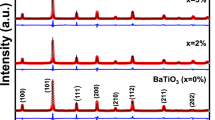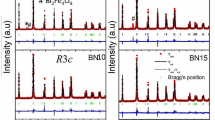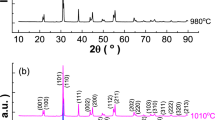Abstract
This study was conducted to understand the nature of the polar state in the morphotropic phase boundary composition 0.67BiFeO3–0.33BaTiO3 (0.67BF–0.33BT). Both the unpoled and poled specimens exhibit an average cubic structure. The poling induces a 0.14% increase in the lattice parameter. Macrodomains are absent both in the initial and polar state of 0.67BF–0.33BT. A typical relaxor-type dielectric anomaly was observed (Tf = ~ 627 K, TB = ~ 820 K). The remnant polarization (Pr), maximum value of electrostrain (Sm), and magnitude strain at Ec in the bipolar mode (Sneg) increase clearly during heating (Pr, ~ 40 µC/cm2; Sm, 0.191% under 40 kV/cm at 453 K). Unlike Bi0.5Na0.5TiO3-based nonergodic relaxors, the first-cycle bipolar electrostrain loops indicate that the minimum strain on the negative side of the bipolar strain curves is negative. Furthermore, the slopes of the relative permittivity versus log frequency plots in unpoled (− 21) and poled (− 23) specimens are similar. The transition between the relaxor state and ferroelectric-like state does not involve a clear dielectric anomaly even in the poled specimen.







Similar content being viewed by others
Data availability
The data that support the findings of this study are available from the corresponding author upon reasonable request.
References
I.H. Ismailzade, R.M. Ismailov, A.I. Alekberov, F.M. Salaev, Investigation of the magnetoelectric (ME)H effect in solid solutions of the systems BiFeO3–BaTiO3 and BiFeO3–PbTiO3. Phys. Status Solidi (a) 68, K81–K85 (1981). https://doi.org/10.1002/pssa.2210680160
M.M. Kumar, A. Srinivas, S.V. Suryanarayana, Structure property relations in BiFeO3/BaTiO3 solid solutions. J. Appl. Phys. 87, 855–862 (2000). https://doi.org/10.1063/1.371953
J.S. Kim, C.I. Cheon, C.H. Lee, P.W. Jang, Weak ferromagnetism in the ferroelectric BiFeO3–ReFeO3–BaTiO3 solid solutions (Re = Dy, La). J. Appl. Phys. 96, 468–474 (2004). https://doi.org/10.1063/1.1755430
A. Singh, V. Pandey, R.K. Kotnala, D. Pandey, Direct Evidence for Multiferroic Magnetoelectric Coupling in 0.9BiFeO3–0.1BaTiO3. Phys. Rev. Lett. 101, 247602 (2008). https://doi.org/10.1103/PhysRevLett.101.247602
S.O. Leontsev, R.E. Eitel, Dielectric and piezoelectric properties in Mn-modified (1 – x)BiFeO3–xBaTiO3 ceramics. J. Am. Ceram. Soc. 92, 2957–2961 (2009). https://doi.org/10.1111/j.1551-2916.2009.03313.x
Y.X. Wei, X.T. Wang, J.J. Jia, X.L. Wang, Multiferroic and piezoelectric properties of 0.65BiFeO3–0.35BaTiO3 ceramic with pseudo-cubic symmetry. Ceram. Int. 38, 3499–3502 (2012). https://doi.org/10.1016/j.ceramint.2011.11.080
H.B. Yang, C.R. Zhou, X.Y. Liu, Q. Zhou, G.H. Chen, H. Wang, W.Z. Li, Structural, microstructural and electrical properties of BiFeO3–BaTiO3 ceramics with high thermal stability. Mater. Res. Bull. 47, 4233–4239 (2012). https://doi.org/10.1016/j.materresbull.2012.09.027
Y.X. Wei, X.T. Wang, J.T. Zhu, X.L. Wang, Dielectric, ferroelectric, and piezoelectric properties of BiFeO3-BaTiO3 ceramics. J. Am. Ceram. Soc. 2013(96), 3163–3168 (2013). https://doi.org/10.1111/JACE.12475
M.H. Lee, D.J. Kim, J.S. Park, W. Kim, T.K. Song, M.H. Kim, W.J. Kim, D. Du, I. Jeong, High-performance lead-free piezoceramics with high Curie temperatures. Adv. Mater. 27, 6976–6982 (2015). https://doi.org/10.1002/ADMA.201502424
D.G. Zheng, R.Z. Zuo, D.S. Zhang, Y. Li, Novel BiFeO3–BaTiO3–Ba(Mg1/3Nb2/3)O3 lead-free relaxor ferroelectric ceramics for energy-storage capacitors. J. Am. Ceram. Soc. 98, 2692–2695 (2015). https://doi.org/10.1111/jace.13737
T. Zheng, Z.G. Jiang, J.G. Wu, Enhanced piezoelectricity in (1 – x)Bi1.05Fe1–yAyO3–xBaTiO3 lead-free ceramics: site engineering and wide phase boundary region. Dalton Trans. 45, 11277–11285 (2016). https://doi.org/10.1039/C6DT01805J
H.L. Zhang, W. Jo, K. Wang, K.G. Webber, Compositional dependence of dielectric and ferroelectric properties in BiFeO3–BaTiO3 solid solutions. Ceram Int 2014(40), 4759–4765 (2014). https://doi.org/10.1016/j.ceramint.2013.09.020
D.W. Wang, A. Khesro, F.A. Murakami, Q.L. Zhao, I.M. Reaney, Temperature dependent, large electromechanical strain in Nd-doped BiFeO3–BaTiO3 lead-free ceramics. J. Eur. Ceram. Soc. 37, 1857–1860 (2017). https://doi.org/10.1016/j.jeurceramsoc.2016.10.027
J.G. Chen, J.R. Chen, Enhanced thermal stability of lead-free high temperature 0.75BiFeO3–0.25BaTiO3 ceramics with excess Bi content. J. Alloy. Compd. 589, 115–119 (2014). https://doi.org/10.1016/j.jallcom.2013.11.169
J.G. Chen, J.R. Chen, J. Guo, J.X. Cheng, J.L. Wang, H.B. Liu, S.J. Zhang, Excellent thermal stability and aging behaviors in BiFeO3–BaTiO3 piezoelectric ceramics with rhombohedral phase. J. Am. Ceram. Soc. 103, 374–381 (2019). https://doi.org/10.1111/jace.16755
I. Calisir, A.A. Amirov, A.K. Kleppe, D.A. Hall, Optimisation of functional properties in lead-free BiFeO3–BaTiO3 ceramics through La3+ substitution strategy. J. Mater. Chem. A 6, 5378–5397 (2018). https://doi.org/10.1039/C7TA09497C
B.W. Xun, N. Wang, B.P. Zhang, K.K. Wang, Enhanced piezoelectric properties of 0.7BiFeO3–0.3BaTiO3 lead-free piezoceramics with high Curie temperature by optimizing Bi self-compensation. Ceram. Int. 45, 24382–24391 (2019). https://doi.org/10.1016/j.ceramint.2019.08.157
D.Y. Fu, Z.H. Ning, D.L. Hu, J.R. Cheng, F.F. Wang, J.G. Chen, Large and temperature-insensitive piezoelectric strain in xBiFeO3–(1 – x)Ba(Zr0.05Ti0.95)O3 lead-free piezoelectric ceramics. J. Mater. Sci. 54, 1153–1161 (2019). https://doi.org/10.1007/s10853-017-1280-6
Q. Li, J.X. Wei, T.L. Tu, J.R. Cheng, J.G. Chen, Remarkable piezoelectricity and stable high-temperature dielectric properties of quenched BiFeO3–BaTiO3 ceramics. J. Am. Soc. Ceram. 100, 5573–5583 (2017). https://doi.org/10.1111/jace.15079
J.X. Wei, D.Y. Fu, J.R. Cheng, J.G. Chen, Temperature dependence of the dielectric and piezoelectric properties of xBiFeO3–(1 – x)BaTiO3 ceramics near the morphotropic phase. J. Mater. Sci. 52, 10726–10737 (2017). https://doi.org/10.1007/S10853-017-1280-6
L. Wang, R.H. Liang, Z.Y. Zhou, X.L. Dong, Thermally stable electrostrain in BiFeO3–BaTiO3-based high temperature lead-free piezoceramics. Appl. Phys. Lett. 115, 08202 (2019). https://doi.org/10.1063/1.5113919
F. AKram, R.A. Malik, T.K. Song, S. Lee, M.-H. Kim, Thermally-stable high dielectric properties of (1–x)(0.65Bi1.05FeO3–0.35BaTiO3)–xBiGaO3 piezoceramics. J. Eu. Ceram. Soc. 39, 2304–2309 (2019). https://doi.org/10.1016/j.jeurceramsoc.2019.02.038
X. Liu, J.W. Zhai, B. Shen, Novel bismuth ferrite-based lead-free incipient piezoceramics with high electromechanical response. J. Mater. Chem. C 7, 5122–5130 (2019). https://doi.org/10.1039/C9TC00826H
Y.X. Wei, C.Q. Jin, Y.M. Zeng, X.T. Wang, D. Gao, X.L. Wang, A coexistence of multi-relaxor states in 0.5BiFeO3–0.5BaTiO3. Ceram. Inter. 43, 17220–17224 (2017). https://doi.org/10.1016/j.ceramint.2017.09.030
G. Wang, J.L. Li, X. Zhang, Z.M. Fan, F. Yang, D. Feteira, Zhou, D.C. Sinclair, T. Ma, X.L. Tan, D.W. Wang, I.M. Reaney, Ultrahigh energy storage density lead-free multilayers by controlled electrical homogeneity. Energy Environ. Sci. 12, 582–588 (2019). https://doi.org/10.1039/C8EE03287D
H.N. Sun, X.J. Wang, Q.Z. Sun, X.X. Zhang, Z. Ma, M.Y. Guo, B.W. Sun, X.P. Zhu, X.J. Lou, Large energy storage density in BiFeO3–BaTiO3–AgNbO3 lead-free relaxor ceramics. J. Eur. Ceram. Soc. 40, 2929–2835 (2020). https://doi.org/10.1016/J.JEURCERAMSOC.2020.03.012
G. Wang, Z.J. Liu, J.L. Li, H.F. Ji, H.J. Yang, L.H. Li, S.K. Sun, A. Feteira, H.G. Yang, R.Z. Zuo, D.W. Wang, I.M. Reaney, Lead-free (Ba,Sr)TiO3–BiFeO3 based multilayer ceramic capacitors with high energy density. J. Eur. Ceram. Soc. 40, 1779–1983 (2020). https://doi.org/10.1016/J.JEURCERAMSOC.2019.12.009
F. Akram, J. Kim, S.A. Khan, A. Zeb, H.G. Yeo, Y.S. Sung, T.K. Song, M.-H. Kim, S. Lee, Less temperature-dependent high dielectric and energy-storage properties of eco-friendly BiFeO3–BaTiO3-based ceramics. J. Alloy Compd. 818, 152878 (2020). https://doi.org/10.1016/j.jallcom.2019.152878
D.W. Wang, G. Wang, S. Murakami, Z.M. Fan, A. Feteira, D. Zhou, S.K. Sun, Q.L. Zhao, I.M. Reaney, BiFeO3–BaTiO3: a new generation of lead-free electroceramics. J. Adv. Dielectr. 8, 1830004 (2018). https://doi.org/10.1142/S2010135X18300049
J.G. Wu, Perovskite lead-free piezoelectric ceramics. J. Appl. Phys. 127, 190901 (2020). https://doi.org/10.1063/5.0006261
S. Kim, G.P. Khanal, H.W. Nam, M. Kim, I. Fujii, S. Ueno, C. Moriyoshi, Y. Kuroiwa, S. Wada, In-situ electric field induced lattice strain response observation in BiFeO3–BaTiO3 lead-free piezoelectric ceramics. J. Ceram. Soc. Jpn. 126, 316–320 (2018). https://doi.org/10.2109/JCERSJ2.17259
G. Wang, Z.M. Fan, S. Murakami, Z.L. Lu, D.A. Hall, D.C. Sinclair, A. Feteira, X.L. Tan, J.L. Jones, A.K. Kleppe, D.W. Wang, I.M. Reaney, Origin of the large electrostrain in BiFeO3–BaTiO3 based lead-free ceramics. J. Mater. Chem. A 7, 21254–21263 (2019). https://doi.org/10.1039/C9TA07904A
T. Zheng, J.G. Wu, Perovskite BiFeO3–BaTiO3 ferroelectrics: engineering properties by domain evolution and thermal depolarization modification. Adv. Electron. Mater. 6, 2000079 (2020). https://doi.org/10.1002/aelm.202000079
W. Jo, J. Rodel, Electric-field-induced volume change and room temperature phase stability of (Bi1/2Na1/2)TiO3−x mol. % BaTiO3 piezoceramics. Appl. Phys. Lett. 99, 042901 (2011). https://doi.org/10.1063/1.3615675
W. Jo, S. Schaab, E. Sapper, L.A. Schmitt, H. Kleebe, A.J. Bell, J. Rodel, On the phase identity and its thermal evolution of lead free (Bi1/2Na1/2)TiO3-6 mol%BaTiO3. J. Appl. Phys. 110, 074106 (2011). https://doi.org/10.1063/1.3645054
B.N. Rao, R. Datta, S.S. Chandrashekaran, D.K. Mishra, V. Sathe, A. Senyshyn, R. Ranjan, Local structural disorder and its influence on the average global structure and polar properties in Na0.5Bi0.5TiO3. Phys. Rev. B 88, 224103 (2013). https://doi.org/10.1103/PHYSREVB.88.224103
B.N. Rao, R. Ranjan, Electric-field-driven monoclinic-to-rhombohedral transformation in Na1/2Bi1/2TiO3. Phys. Rev. B 86, 134103 (2012). https://doi.org/10.1103/PHYSREVB.86.134103
Q. Li, J.X. Wei, J.R. Cheng, J.G. Chen, High temperature dielectric, ferroelectric and piezoelectric properties of Mn-modified BiFeO3–BaTiO3 lead-free ceramics. J. Mater. Sci. 52, 229–237 (2017). https://doi.org/10.1007/s10853-016-0325-6
S. Murakami, D.W. Wang, A. Mostaed, A. Khesro, A. Feteira, D.C. Sinclair, Z.M. Fan, X.L. Tan, I.M. Reaney, High strain (0.4%) Bi(Mg2/3Nb1/3)O3–BaTiO3–BiFeO3 lead-free piezoelectric ceramics and multilayers. J. Am. Ceram. Soc. 101, 5428–5442 (2018). https://doi.org/10.1111/jace.15749
C.-H. Hong, H.Z. Guo, X.L. Tan, J.E. Daniel, W. Jo, Polarization reversal via a transient relaxor state in nonergodic relaxors near freezing temperature. J. Mater. 5, 634–640 (2019). https://doi.org/10.1016/j.jmat.2019.06.004
R.D. Shannon, Revised effective ionic radii and systematic studies of interatomic distances in halides and chalcogenides. Acta Cryst. A32, 751–767 (1976). https://doi.org/10.1107/S0567739476001551
A. Goaz, V. Uvarov, I. Popov, S. Shenawi-khalil, Y. Sasson, A new anhydrous bismuth potassium nitrate, K3Bi2(NO3)9: synthesis, structure characterization and thermal decomposition. J. Alloys Comp. 514, 30–34 (2012). https://doi.org/10.1002/chin.201210018
A.A. Bokov, Z.G. Ye, Recent progress in relaxor ferroelectrics with perovskite structure. J. Mater. Sci. 41, 31–52 (2006). https://doi.org/10.1007/s10853-005-5915-7
H.X. Yan, F. Inam, G. Viola, H.P. Ning, H.T. Zhang, Q.H. Jiang, T. Zeng, Z.P. Gao, M.J. Reece, The contribution of electrical conductivity, dielectric permittivity and domain switching in ferroelectric hysteresis loops. J. Adv. Dielectr. 1, 107–118 (2011). https://doi.org/10.1142/S2010135X11000148
L.F. Zhu, Q. Liu, B.P. Zhang, Z.Y. Chen, K. Wang, J.J. Li, Y. Bai, X.H. Wang, J.F. Li, Temperature independence of piezoelectric properties for high-performance BiFeO3–BaTiO3 lead-free piezoelectric ceramics up to 300 °C. RSC Adv. 8, 35794–35801 (2018). https://doi.org/10.1039/C8RA07553K
W. Jo, R. Dittmer, M. Acosta, J.D. Zang, C. Groh, E. Sapper, K. Wang, J. Rodel, Giant electric-field-induced strains in lead-free ceramics for actuator applications–status and perspective. J. Electroceram. 29, 71–93 (2012). https://doi.org/10.1007/s10832-012-9742-3
J. Yin, H. Tao, G. Liu, J.G. Wu, Domain-scale imaging to dispel the clouds over the thermal depolarization of Bi0.5Na0.5TiO3-based relaxor ferroelectrics. J. Am. Ceram. Soc. 103, 1881–1890 (2020). https://doi.org/10.1111/jace.16908
N.H. Khansur, J. Biggemann, M. Stumpf, K. Riess, T. Fey, K.G. Webber, Temperature- and stress-dependent electromechanical response of porous Pb(Zr, Ti)O3. Adv. Eng. Mater. (2020). https://doi.org/10.1002/adem.202000389
A. Sehirlioglu, D.A. Payne, P.D. Han, Effect of poling on dielectric anomalies at phase transitions for lead magnesium niobate-lead titanate crystals in the morphotropic phase boundary region. J. Appl. Phys. 99, 064101 (2006). https://doi.org/10.1063/1.2179972
Q. Li, J. Wang, Y. Ma, L. Ma, G.Z. Dong, H.Q. Fan, Enhanced energy-storage performance and dielectric characterization of 0.94Bi0.5Na0.5TiO3–0.06BaTiO3 modified by CaZrO3. J. Alloy. Compd. 663, 701–707 (2016). https://doi.org/10.1016/j.jallcom.2015.12.194
S.M. Ke, H.Q. Fan, H.T. Huang, H.L.W. Chan, S.H. Yu, Dielectric dispersion behavior of BaZrxTi1–xO3 solid solutions with a quasiferroelectric state. J. Appl. Phys. 104, 034108 (2008). https://doi.org/10.1063/1.2964088
F. Li, S.J. Zhang, D. Damjanovic, L.-Q. Chen, T.R. Shrout, Local structural heterogeneity and electromechanical responses of ferroelectrics: learning from relaxor ferroelectrics. Adv. Funct. Mater. 28, 1801514 (2018). https://doi.org/10.1002/adfm.201801504
D. Maurya, A. Pramanick, M. Feygenson, J.C. Neuefeind, R.J. Bodnar, S. Priya, Effect of poling on nanodomains and nanoscale structure in A-site disordered lead-free piezoelectric Na0.5Bi0.5TiO3–BaTiO3. J. Mater. Chem. C 2, 8423–8431 (2014). https://doi.org/10.1039/C4TC01124D
J.Y. Zhao, N. Zhang, W. Ren, G. Niu, D. Walker, P.A. Thomas, L.Y. Wang, Z.-G. Ye, Polar domain structural evolution under electric field and temperature in the (Bi0.5Na0.5)TiO3–0.06BaTiO3 piezoceramics. J. Am. Ceram. Soc. 102, 437–447 (2019). https://doi.org/10.1111/jace.15883
X. Shi, N. Kumar, M. Hoffman, Electric field–temperature phase diagrams for (Bi1/2Na1/2)TiO3–BaTiO3–(K1/2Na1/2)NbO3 relaxor ceramics. J. Mater. Chem. C 6, 12224–12233 (2018). https://doi.org/10.1039/C8TC04189J
Acknowledgements
This work was financially supported by the National Natural Science Foundation of China (Project No. 11704301), the Natural Science Basic Research Plan in Shaanxi Province of China (Program No. 2018JQ1092), the Shaanxi Provincial Education Department Program (Program No.19JK0398), and the President’s Fund of Xi’an Technological University (Project no. XAGDXJJ18006).
Author information
Authors and Affiliations
Corresponding author
Additional information
Publisher's Note
Springer Nature remains neutral with regard to jurisdictional claims in published maps and institutional affiliations.
Rights and permissions
About this article
Cite this article
Wei, Y., Shen, J., Bai, C. et al. Nature of polar state in 0.67BiFeO3–0.33BaTiO3. J Mater Sci: Mater Electron 31, 19266–19276 (2020). https://doi.org/10.1007/s10854-020-04462-9
Received:
Accepted:
Published:
Issue Date:
DOI: https://doi.org/10.1007/s10854-020-04462-9




